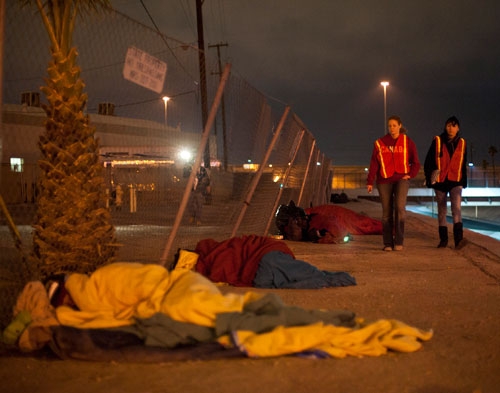Homeless count helps gauge need, gather data for grants
Everything's quiet in downtown's homeless corridor this still-dark Thursday morning.
But that doesn't mean it's empty.
Men and women lie side-by-side, tucked in tattered sleeping bags, on a sidewalk near the train tracks. Some curl up against the facades of businesses along Main Street. Still others set up camp just yards from a homeless shelter on Las Vegas Boulevard at Foremaster Lane.
Those who live here are used to sleeping through the cold. Most don't know they're being counted, at 3 a.m., by a small army of volunteers.
This happens every two years, in January. Hundreds of volunteers and homeless "guides," working in teams, fan out across the Las Vegas Valley for a nighttime count.
The numbers are combined with those gathered during a separate count in rural Clark County and from shelters, hospitals and other sources for an estimate of the number of homeless people living here on a given day.
It gives social service providers an idea of how the local homeless population has changed and data needed to apply for federal grant money to fight homelessness.
Similar counts are happening across the country.
All the activity stirs Shawanda Robinson, 38, who is lying on the sidewalk next to a man she identifies as her grandfather.
"We stay out here every night," she says while wiping a few raindrops from her arms. "I get claustrophobic in the shelter."
When she gets hungry, she snacks on raw potatoes.
This is the area officials call the Corridor of Hope - a cluster of shelters, empty lots, businesses and graveyards - where homeless people tend to gather because of the resources available.
The last count, in 2011, revealed a large increase in the number of people living on the streets in the corridor and surrounding neighborhoods despite a sizable decrease in the overall number of homeless in the valley.
Social service providers said cuts in safety-net programs during a dismal economy were to blame for putting more people on the streets.
Those who work with the homeless population have since focused more outreach efforts in the downtown area, said Tyrone Thompson, regional initiatives coordinator for the Southern Nevada Regional Planning Coalition.
"We've been building stronger teams of professionals" who have substance abuse and mental health training to do outreach, he said.
"As monetary resources are shrinking, we have to be creative to put it all together for those in need."
Many of those professionals are along for the count this morning, including Ethel Simpson, a case manager for Women's Development Center, an organization that helps homeless people find housing and jobs, among other services.
"Every story is different," Simpson says. "In this economy, the slightest change in circumstances can lead to homelessness."
She and her teammates search their assigned census track with flashlights, investigating alleys, dirt lots, washes and underpasses. Counting.
They don't interact with anybody they come across today.
"It's strictly a visual count," Thompson says. "We do it at this hour because everybody is stationary."
Leading the team is a 40-year-old man who asks not to be identified by name. He has lived in a shelter at Catholic Charities of Southern Nevada since being released from prison a couple of months ago. After spending more than two years incarcerated on drug-related charges, he had nowhere else to go.
He spent his first night of freedom riding the bus all over town. Then he moved into the shelter. He works in the warehouse as part of a resident work program.
"It's sad out here," he says.
"Some are out here because of drug or alcohol abuse. But plenty just fell on hard times. I make sure I strive just a little harder so it doesn't happen to me."
After the last count, regional officials were pleased to discover the overall homeless population in Clark County had decreased by more than 29 percent - from 13,338 in 2009 to 9,432 in 2011.
They attributed the decrease in part to better collaboration between local governments, nonprofits and faith-based groups that help the homeless.
But some social service providers said the numbers didn't reflect what they were seeing on the streets.
Indeed, the count revealed a sharp increase - about 40 percent - in the number of unsheltered "street" homeless in 2011.
The overall decrease was thanks to shrinking numbers of "sheltered" and "hidden" homeless, people living in homeless shelters, transitional housing and in unconverted garages or other private property not meant for shelter.
It follows that some of those people wound up on the street.
Also in 2011, about 29 percent of the entire valley's street homeless were found in or around the downtown homeless corridor.
And the number of people living in the area spiked between 2009 and 2011. In 2009, 377 people were counted there. In 2011, that number was 1,245 - a 230 percent increase.
Officials won't know immediately whether stepped-up efforts in the area have helped. The count's final results are expected in the spring.
Contact Lynnette Curtis at Lynnette.Curtis@yahoo.com.

















